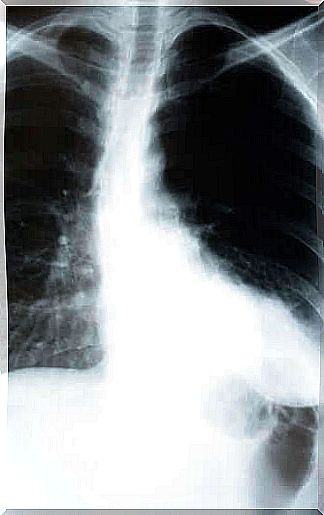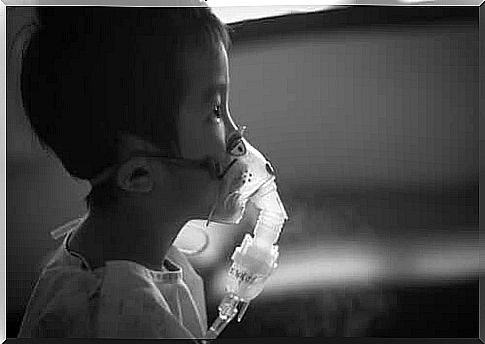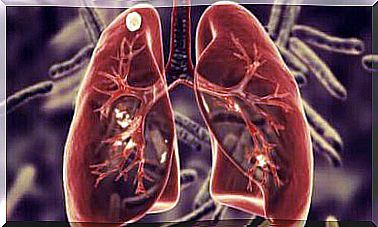How Pneumonia Affects The Body

Pneumonia is an infection that affects the alveoli in the lungs. These are small sacs covered by blood vessels, which perform the exchange of air. In other words, they are responsible for emitting carbon dioxide (CO2) and capturing oxygen from the outside. The question of how pneumonia affects the body is so important – because air exchange is such an important process.
There are about 2 to 10 cases of pneumonia per 1000 citizens per year. Out of these cases, between 20 and 35% require hospitalization. In patients with other diseases, the mortality rate is 1%, but it can increase to 40% in inpatients, especially those in intensive care. Depending on the patient’s situation, pneumonia can be life threatening.
In this article, we will explain the process that your body goes through, from the time it becomes infected until the disease occurs. In doing so, we will reveal how pneumonia affects the body.
How pneumonia affects the body
Pneumonia is the consequence of two separate conditions that occur simultaneously:
- The arrival of microorganisms in the alveoli and the subsequent spread of them.
- An inflammatory reaction from the host, which will condition the clinical manifestaion and how serious the disease becomes.
How do these microorganisms reach the lungs?
Bacteria, viruses, fungi and parasites are all capable of causing pneumonia, but bacteria and viruses are usually the culprits. Right now, experts are identifying more and more viruses and the causes of pneumonia. There are two types of pneumonia that can occur:
- Pneumonia as a result of a viral infection: This is called primary pneumonia. For example, pneumonia associated with SARS-CoV-2 (COVID-19) falls within this category.
- Bacterial pneumonia due to a viral infection of the respiratory tract. For example, bacterial pneumonia is a common complication of influenza.

Our airways are constantly exposed to microorganisms. Bacteria, viruses and other microorganisms can form colonies in our lungs in the following ways:
1. Inhalation of microorganisms in the throat
Our respiratory and digestive systems are closely connected thanks to the pharynx. The pharynx connects the nose and mouth to the larynx (respiration) and the esophagus (digestion).
The food we eat should only penetrate the esophagus once it has passed through the pharynx. In the same way, only air should penetrate into the larynx. We therefore possess a structure known as the larynx, which closes the larynx and carries food towards the esophagus.
All individuals have bacteria and sometimes even viruses in their cavities in the nose and mouth, which usually do not cause harm. The larynx, trachea and lungs must remain sterile. In other words, they should not contain any microorganisms because this can lead to an infection. As we have explained, therefore, only air should penetrate into the larynx.
While we sleep, the muscles in the pharynx and larynx relax, which can allow for microaspiration. This refers to the passage of small amounts of saliva, food, etc. from the pharynx to the larynx.
These microaspirations may contain microorganisms which reach the lungs after passing through the larynx. This is the mechanism that occurs in the majority of individuals who develop pneumonia as well as healthy individuals without any disease.
At the same time, some people do not have proper control over their larynx. This causes them to get large amounts of aspirations of food, beverages or saliva against their larynx. As a result, colonization occurs in their lungs.
2. Dissemination of inhalation
Individuals regularly inhale small amounts of microorganisms from the air, which can find their way into the airways. These microorganisms can come from an infected person who coughs or sneezes without protection and then infects the people in the area.
3. Hematogenous mediation
This mechanism of infection usually occurs in people with a weakened immune system. In other words, their body does not have a strong defense mechanism to fight infections.
For example, these individuals may have bacteria circulating in their blood. These bacteria then pass to their airways, where they later affect their lungs. Overall, hematogenous mediation involves the passage of microorganisms from the blood to the lungs. Fortunately, this type of infection is very rare.
4. As a result of an infection of the pleura or thoracic septum
The lungs are surrounded by a layer known as the pleura. This mucosa can become infected and the infection can spread to the lungs as a result. Between the lungs, we also find different structures that make up the breast septum, where we find the lungs, for example.
Sometimes this area can also suffer from infections that can spread to the lungs.
5. Pneumonia from hospitals
At the hospital, people who are hospitalized due to other illnesses can end up getting pneumonia. The most common mechanism of infection for this type of pneumonia is associated with aids to breathing. In other words, it occurs in patients with intubators or respirators.
Intubation consists of leading a tube directly from the outside down into the larynx. This keeps the larynx from performing its task of keeping the airways free of microorganisms. Exogenous pathogens then find it easier to penetrate the lungs and cause infection.
Intubation should therefore only take place in special situations where the patient’s life is in danger and he or she is unable to breathe in any other way.

Defense mechanisms when pneumonia affects the body
If these microorganisms penetrate into the lungs, then they are usually easily excreted by our body’s defense mechanisms, which involves:
- The cough reflex, which helps excrete mucus and foreign bodies.
- The cilia of the cells that cover the airways, which keep the microorganisms from invading the lungs. These cilia are small mobile fibers that push mucus and foreign bodies upward so that it can be excreted through the sneeze.
- The cells in the lungs produce substances that attack microorganisms and destroy them.
- In the lungs, there are cells from the body’s defense system. These cells are there naturally and protect the alveoli. They are called macrophages and their function is to “eat” microorganisms and kill them.
When these defense mechanisms fail, then either the microorganism is very strong or the person has inhaled a large amount of microorganisms. As a result, pneumonia occurs.
How does the body react?
If the primary defense mechanisms have been unable to excrete the microorganisms, our bodies start an inflammatory response. This inflammatory reaction is caused by the release of substances by the macrophages:
- Substances that produce fever. The body produces this reaction because higher temperatures can cause the inactivation of microorganisms and destroy them more easily.
- Substances that attract other defense cells, such as neutrophils. At the same time, neutrophils produce purulent secretions. This can cover the alveoli and deter them from performing the exchange of air. This produces a feeling of being suffocated because oxygen does not reach the blood.
In order to better understand this, we will use the following analogy. The macrophages are soldiers who are at the forefront of the battle. If they realize they are losing, they call on reinforcements that can help them overcome the enemy. This reinforcement will be the rest of the defense cells.
The amplification that the macrophages attract can lead to clinical manifestation, which is harmful to the host. Therefore, in order to deter the body from producing these defensive reactions , the patient must receive proper treatment to eliminate the microorganisms.
Conclusion: How pneumonia affects the body
In conclusion, we need to understand that clinical manifestations of pneumonia are not caused by pathogens alone. Rather, they are the result of a person’s inflammatory reaction.
People with a strong immune system will therefore have more symptoms than a person with a weakened immune system.









